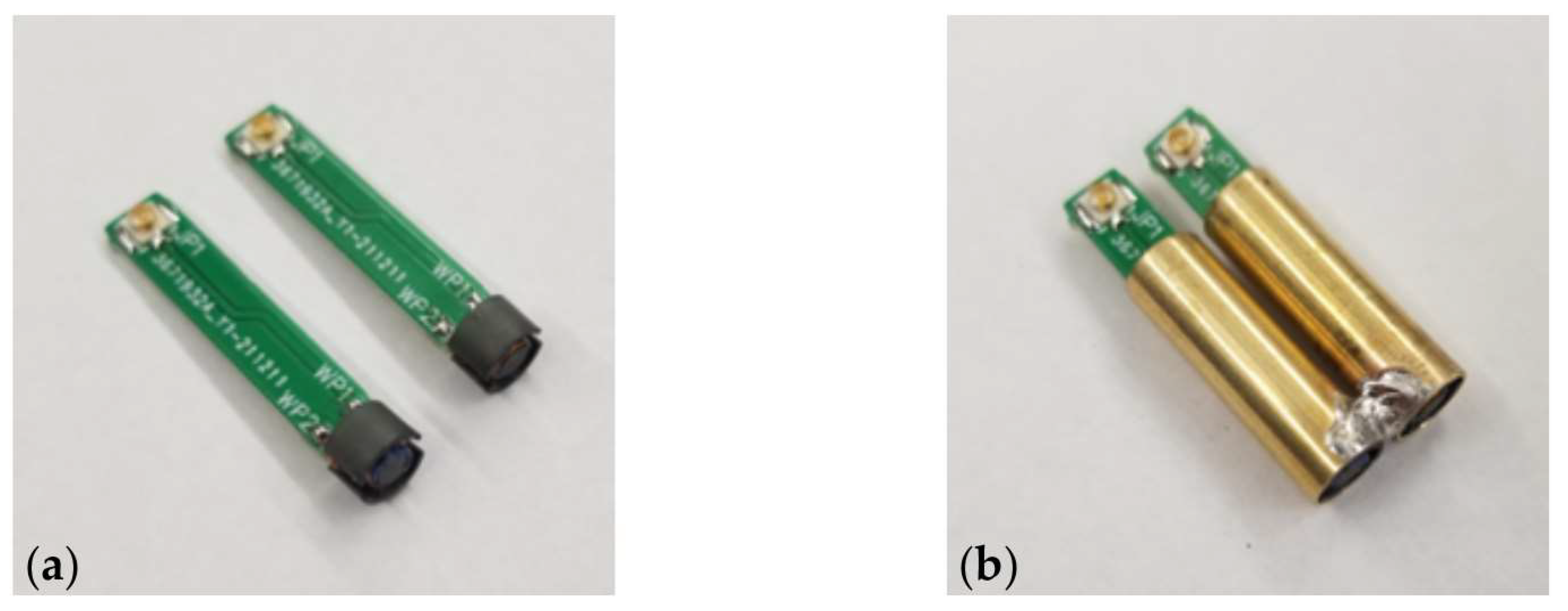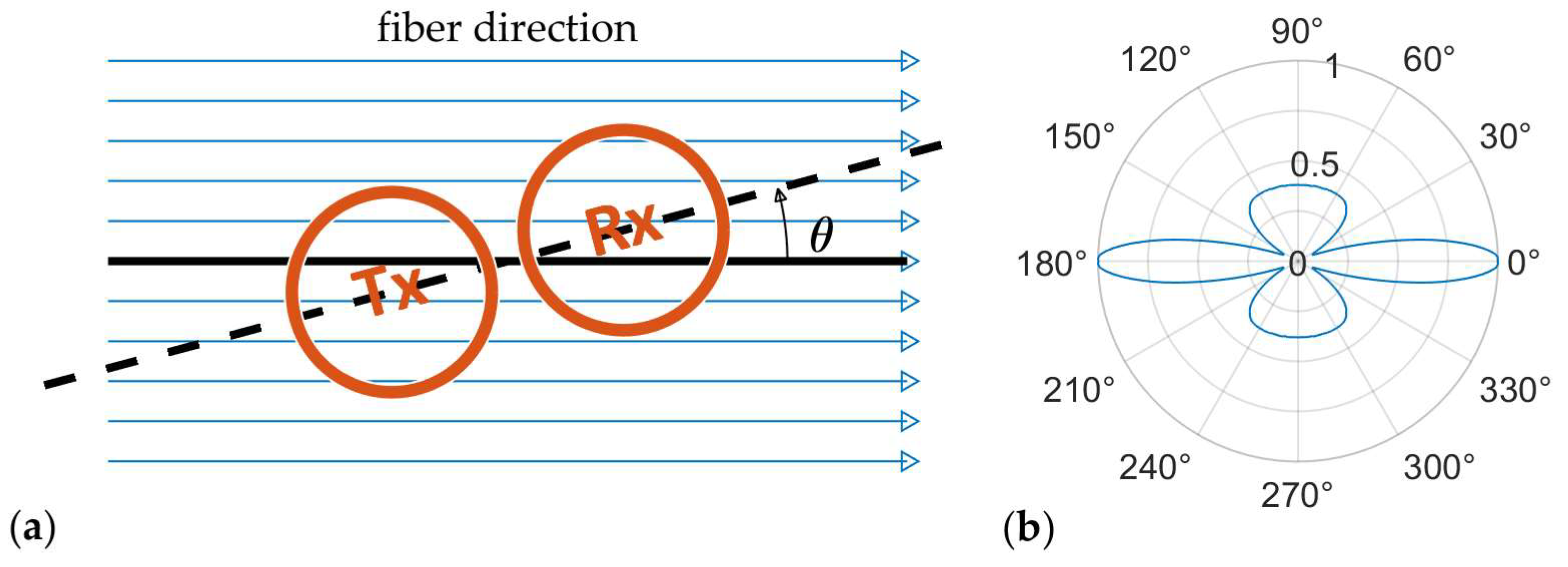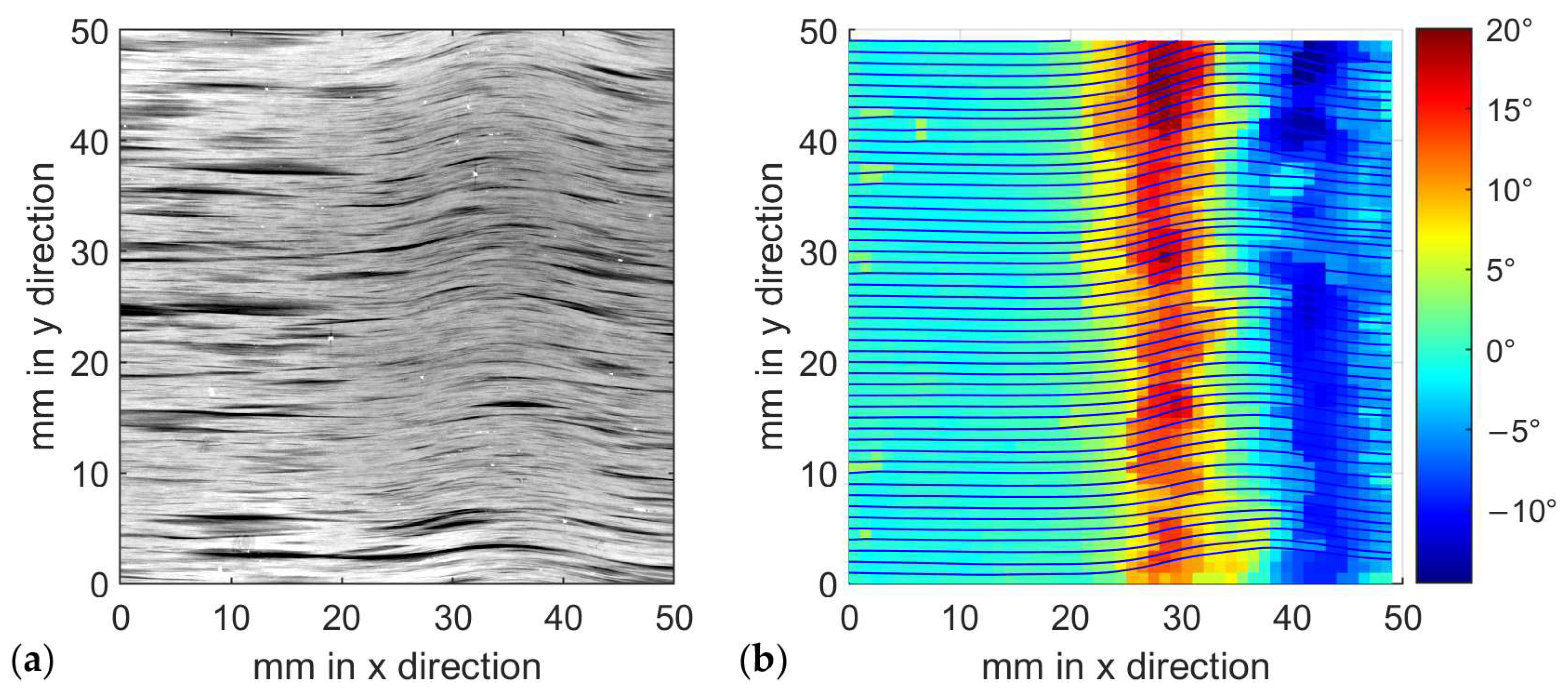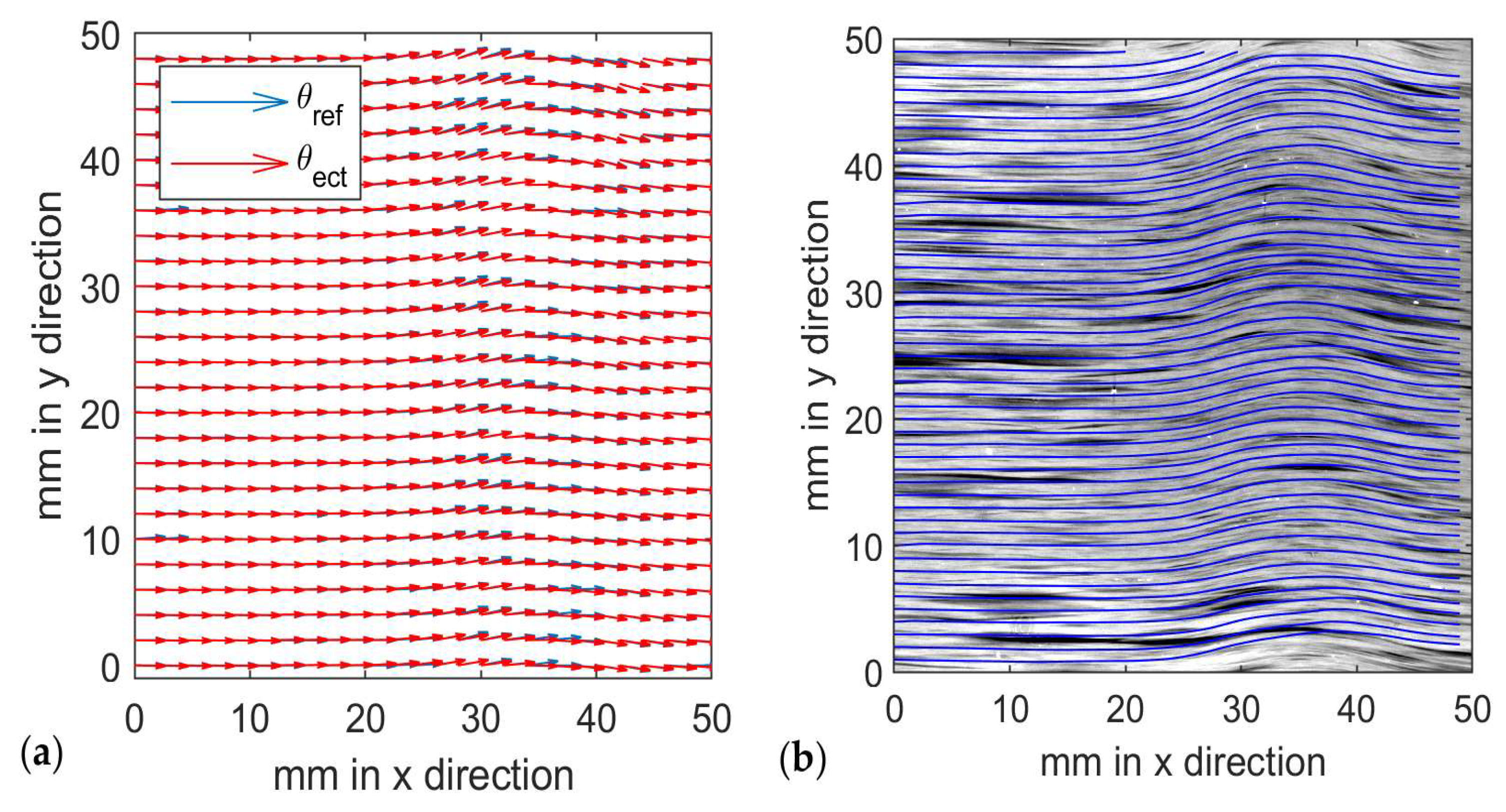Non-Destructive Evaluation of In-Plane Waviness in Carbon Fiber Laminates Using Eddy Current Testing
Abstract
1. Introduction
2. Materials and Methods
2.1. Manufacturing the CFRP Sample with in-Plane Waviness
2.2. Manufacturing the Custom ECT Probe
2.3. Experimental ECT System
2.4. IQ Demodulation
2.5. Scanning Methodology
2.6. Reference/Ground Truth Data Collection
2.6.1. X-ray Computed Tomography
2.6.2. Pulse/Echo Ultrasonic Testing
3. Results
4. Discussion
5. Conclusions
Author Contributions
Funding
Institutional Review Board Statement
Informed Consent Statement
Data Availability Statement
Acknowledgments
Conflicts of Interest
References
- Jones, R. Mechanics of Composite Materials; CRC Press: Boca Raton, FL, USA, 1998. [Google Scholar]
- Li, Z.; Haigh, A.; Soutis, C.; Gibson, A.; Sloan, R.; Karimian, N. Detection and evaluation of damage in aircraft composites using electromagnetically coupled inductors. Compos. Struct. 2016, 140, 252–261. [Google Scholar] [CrossRef]
- Piggott, M.R. The effect of fibre waviness on the mechanical properties of unidirectional fibre composites: A review. Compos. Sci. Technol. 1995, 53, 201–205. [Google Scholar] [CrossRef]
- Blackman, N.; Jack, D. Novel Technique for the Automated Determination of the Ply Stack for a Woven Carbon Fiber Composite using High-Frequency Pulse Echo Ultrasound. Compos. Part B, 2022; under review. [Google Scholar]
- Newton, M.; Gravagne, I.; Jack, D. Normalization and Processing of Rotational Eddy Current Scans for Layup Characterization of CFRP Laminates. In Proceedings of the ASNT Research Symposium, Columbus, OH, USA, 26–30 June 2023. [Google Scholar]
- Dvorsky, M.; Munalli, D.; Al Qaseer, M.T.; Zoughi, R. Application of Microwave Polarimetry to the Characterization of Fiber Misalignment in Composites. IEEE Open J. Instrum. Meas. 2022, 1, 1–9. [Google Scholar] [CrossRef]
- Hughes, R.; Drinkwater, B.; Smith, R. Characterisation of carbon fibre-reinforced polymer composites through radon-transform analysis of complex eddy-current data. Compos. Part B Eng. 2018, 148, 252–259. [Google Scholar] [CrossRef]
- Kosukegawa, H.; Kiso, Y.; Hashimoto, M.; Uchimoto, T.; Takagi, T. Evaluation of detectability of differential type probe using directional eddy current for fibre waviness in CFRP. Philos. Trans. R. Soc. A 2020, 378, 20190587. [Google Scholar] [CrossRef] [PubMed]
- Mizukami, K.; Mizutani, Y.; Todoroki, A.; Suzuki, Y. Detection of in-plane and out-of-plane fiber waviness in unidirectional carbon fiber reinforced composites using eddy current testing. Compos. Part B Eng. 2016, 86, 84–94. [Google Scholar] [CrossRef]
- Zeng, Z.; Wang, J.; Liu, X.; Lin, J.; Dai, Y. Detection of fiber waviness in CFRP using eddy current method. Compos. Struct. 2019, 229, 111411. [Google Scholar] [CrossRef]
- Mizukami, K.; Mizutani, Y.; Kimura, K.; Sato, A.; Todoroki, A.; Suzuki, Y.; Nakamura, Y. Visualization and size estimation of fiber waviness in multidirectional CFRP laminates using eddy current imaging. Compos. Part A Appl. Sci. Manuf. 2016, 90, 261–270. [Google Scholar] [CrossRef]
- Wincheski, R.A.; Zhoa, S. Development of eddy current probe for fiber orientation assessment in carbon fiber composites. In Proceedings of the AIP Conference Proceedings, Provo, UT, USA, 5–6 July 2018. [Google Scholar]
- Newton, M.; Chowdhury, T.; Gravagne, I.; Jack, D. Nondestructive Detection of In-Plane Wrinkles in Carbon Fiber Laminates Using Eddy Current and Ultrasonic Testing. In Proceedings of the ASNT Research Symposium, St. Louis, MO, USA, 20–23 June 2022. [Google Scholar]
- Wu, C.; Gu, Y.; Luo, L.; Xu, P.; Wang, S.; Li, M.; Zhang, Z. Influences of in-plane and out-of-plane fiber waviness on mechanical properties of carbon fiber composite laminate. J. Reinf. Plast. Compos. 2018, 37, 3–891. [Google Scholar] [CrossRef]
- Nair, S.N.; Dasari, A.; Yue, C.Y.; Narasimalu, S. Failure Behavior of Unidirectional Composites under Compression Loading: Effect of Fiber Waviness. Materials 2017, 10, 909. [Google Scholar] [CrossRef] [PubMed]
- Cheng, J.; Ji, H.; Qiu, J.; Takagi, T.; Uchimoto, T.; Hu, N. Role of interlaminar interface on bulk conductivity and electrical anisotropy of CFRP laminates measured by eddy current method. Ndt E Int. 2014, 68, 1–12. [Google Scholar] [CrossRef]
- Li, X. Eddy Current Techniques for Non-Destructive Testing of Carbon Fibre Reinforced Plastic (CFRP); The University of Manchester: Manchester, UK, 2012. [Google Scholar]
- Cheng, J.; Qiu, J.; Xo, X.; Ji, H.; Takagi, T.; Uchimoto, T. Research advances in eddy current testing for maintenance of carbon fiber reinforced plastic composites. Internation J. Appl. Electromagn. Mech. 2016, 51, 261–284. [Google Scholar] [CrossRef]
- Minnie, W. Nontdestructive Evaluation of Out-Of-Plane Wrinkles within Woven Carbon Fiber Reinforced Plastics (CFRP) Using Ultrasonic Detection. Ph.D. Thesis, Baylor University, Waco, TX, USA, 2021. [Google Scholar]
- Berger, D.; Lanza, G. Development and Application of Eddy Current Sensor Arrays for Process Integrated Inspection of Carbon Fibre Preforms. Sensors 2017, 18, 4. [Google Scholar] [CrossRef] [PubMed]
- Naidjate, M.; Helifa, B.; Feliachi, M.; Lefkaier, I.-K.; Heuer, H.; Schulze, M. A Smart Eddy Current Sensor Dedicated to the Nondestructive Evaluation of Carbon Fibers Reinforced Polymers. Sensors 2017, 17, 1996. [Google Scholar] [CrossRef] [PubMed]











| Average max angle, | 12.68° | 10.40° | - |
| Average width 1 | 24.22 mm | 26.80 mm | - |
| Total variance | 6° | 4.4° | 3° |
| Total RMSE | - | - | 3° |
Disclaimer/Publisher’s Note: The statements, opinions and data contained in all publications are solely those of the individual author(s) and contributor(s) and not of MDPI and/or the editor(s). MDPI and/or the editor(s) disclaim responsibility for any injury to people or property resulting from any ideas, methods, instructions or products referred to in the content. |
© 2023 by the authors. Licensee MDPI, Basel, Switzerland. This article is an open access article distributed under the terms and conditions of the Creative Commons Attribution (CC BY) license (https://creativecommons.org/licenses/by/4.0/).
Share and Cite
Newton, M.; Chowdhury, T.; Gravagne, I.; Jack, D. Non-Destructive Evaluation of In-Plane Waviness in Carbon Fiber Laminates Using Eddy Current Testing. Appl. Sci. 2023, 13, 6009. https://doi.org/10.3390/app13106009
Newton M, Chowdhury T, Gravagne I, Jack D. Non-Destructive Evaluation of In-Plane Waviness in Carbon Fiber Laminates Using Eddy Current Testing. Applied Sciences. 2023; 13(10):6009. https://doi.org/10.3390/app13106009
Chicago/Turabian StyleNewton, Matthew, Tonoy Chowdhury, Ian Gravagne, and David Jack. 2023. "Non-Destructive Evaluation of In-Plane Waviness in Carbon Fiber Laminates Using Eddy Current Testing" Applied Sciences 13, no. 10: 6009. https://doi.org/10.3390/app13106009
APA StyleNewton, M., Chowdhury, T., Gravagne, I., & Jack, D. (2023). Non-Destructive Evaluation of In-Plane Waviness in Carbon Fiber Laminates Using Eddy Current Testing. Applied Sciences, 13(10), 6009. https://doi.org/10.3390/app13106009






